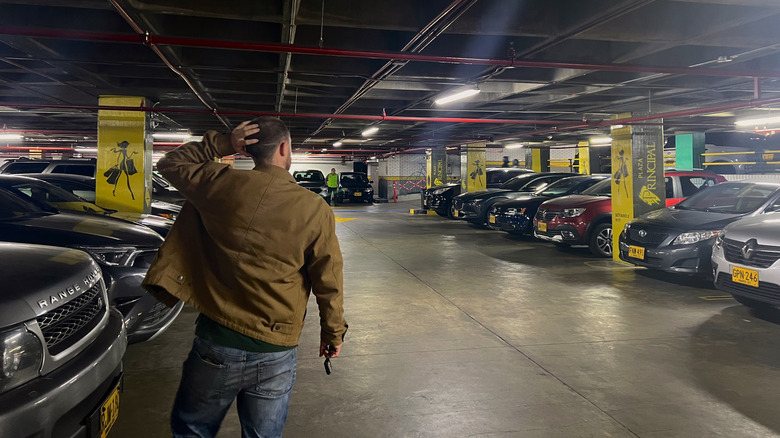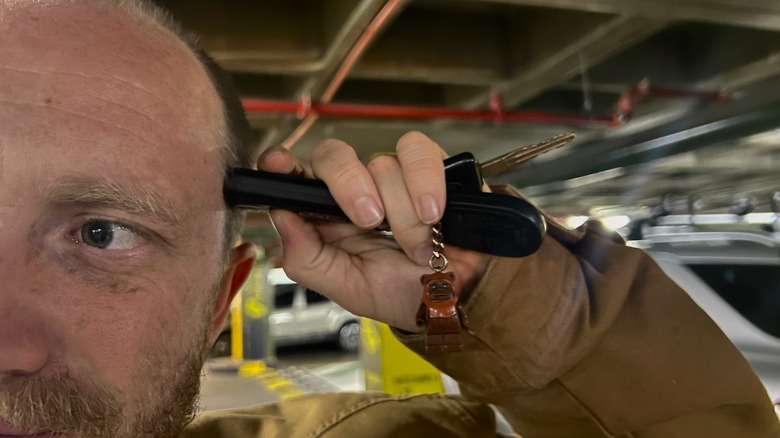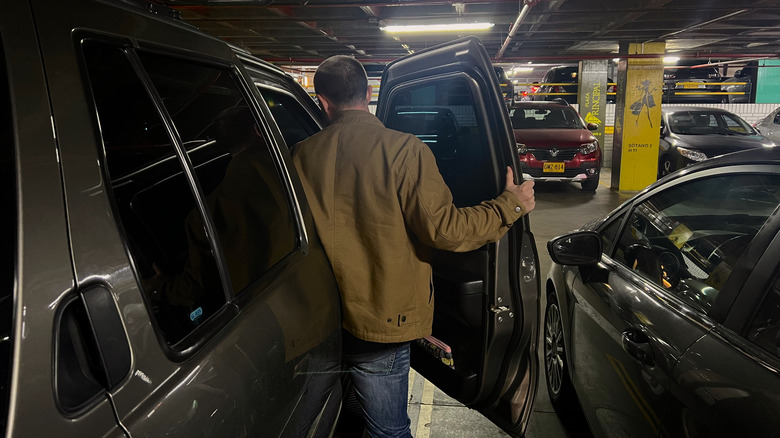We Tried This Science-Approved Hack To Find Your Car Quickly In A Packed Airport Parking Lot
Picture this: You're coming back home after some time away, feeling refreshed and invigorated, when — all of a sudden — the realization hits you. You can't remember exactly where you parked your car at the airport. Damn. And while you poke around and search to no avail, your bags start to feel a little heavy, your back starts to sweat, and your patience starts to wear thin. After all, no one likes to play a game of "Dude, Where's My Car?" after a long trip — especially not while hauling around a heavy suitcase behind them.
Luckily, you remember a random online video that popped up on your feed weeks ago, which claimed that you can use your head to expand your car remote's reach. Reluctantly, you try it out. Beep beep. Lights flash in the distance, the smile returns to your face, and you're finally free to go on your way.
Does it sound too good to be true? We thought so, too. That's why — armed with a car remote, two co-pilots (one human and one dog), and some curiosity — I decided to put the so-called hack to the test myself to try and settle the long-standing debate.
Using your head as a car remote antenna
The explanation behind the hack is relatively simple. Basically, it all boils down to the fact that our bodies can help the radio signals from the remote get a bit stronger. Why? Because we're made up of mostly water — around 60% — and water is great at carrying these signals much further than if they were simply traveling on their own.
With this in mind, when you hold the remote close to your head, all that water inside you combines with the radio frequency (RF) waves of the controller to create a dielectric resonator — which is basically a fancy term for something that enhances signal propagation. This ultimately means that, since the signal spreads out more, your car can respond from a farther distance. In other words, it's like turning your head into a mini-antenna. Except, in this case, it's not necessarily your TV signal that's getting a boost — it's your sanity.
If you're worried about radio signals weaving through your brain, there's no need to be. According to Tom Wrigglesworth, an electrical engineer in conversation with the Science Channel, the remote's power is so minimal that it won't significantly affect you, your health, or your brain in any negative way. However, if you're still dubious, you can actually hold the remote against a water bottle instead of your head and get the same result.
Putting the so-called hack to the test
Since I didn't really have a reason to head to the airport — and airport parking is pretty expensive and terrible, anyway — I decided to try the next best thing: the mall. Large, underground, and jam-packed with cars on most days, I felt it was the most ideal setting to try and conduct the experiment — with a few added variables thrown in there for good fun. After all, most of the videos I'd seen online were of empty, outdoor parking lots, with just one car visible in the distance. That wasn't going to cut it.
Once my co-pilot and I arrived at the mall, I parked the car in between a row of vehicles, locked it, and walked away. Per the Museum of Science's TikTok, car remote signals work when you're anywhere between 16 to 65 feet away. With that in mind, we walked roughly 90 to 100 feet away (pulling out a measuring tape would have probably worried the already-suspicious security guard standing nearby) and pressed the button. No luck. I pressed it again, holding it above our heads and over the row of cars that — in our unscientific opinion — might be interfering with the signal. Still nothing.
Then, the moment of truth: holding the car remote to his head, my partner pressed the unlock button once more. Beep beep. Eureka! Success! Hooray! To verify, we pressed the lock button once again. Beep beep. Our job here was done.
So, does holding the remote to your head actually work?
Testing out the car-remote-to-head experiment isn't anything new. In fact, the team over at Altair (a software and cloud computing company) have a pretty extensive and very science-oriented breakdown of their own version of the experiment. The hack's actually so popular that my partner had even heard about it from a few years back — except he never believed it was true.
So, did it work to help us find our car? In short: Yeah, it did. However, there are plenty of other elements to consider that still make this experiment a little misleading — things that my fifth grade science teacher, for one, wouldn't have let slide. First, both of us knew exactly where the car was parked. This could have inadvertently affected the way we stood or pointed the remote compared to if we hadn't known where we parked. Additionally, we were still pretty close to the car, even though we were farther than the 65-feet maximum. Another factor is that our Nissan was 20 years old, so perhaps a new car would react differently.
All in all, though, it's a great trick to have up your sleeve if you're in a bind. If you're truly that worried about "misplacing" your car after a trip, I suggest opting for a ride-share or taxi to do the driving instead. That way, you won't need to rely on any hacks when it comes to making your way back home.


